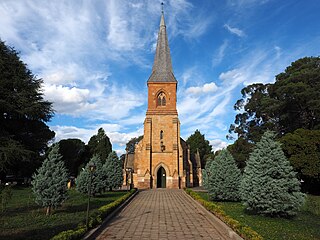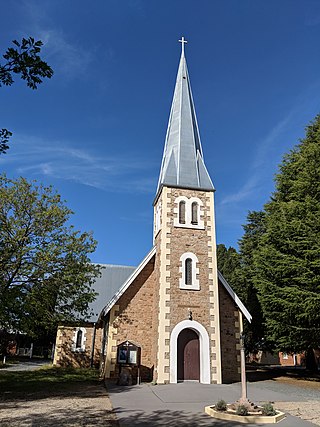Related Research Articles

St John the Baptist Church is an Australian Anglican church in the Canberra suburb of Reid in the Australian Capital Territory. It is the oldest surviving public building within Canberra's inner city and the oldest church in the Australian Capital Territory, dating back to 1845, and contains several medieval stones, including a 12th century stone from Canterbury Cathedral and a 13th century stone from Westminster Abbey. The church is located at the corner of Anzac Parade and Constitution Avenue, adjacent to the Parliamentary Triangle.

The Diocese of Riverina is one of 23 dioceses of the Anglican Church of Australia. The diocese covers 37% of New South Wales, including the Riverina and the far west of the state. The diocese was established in 1884 when the Diocese of Goulburn was divided.

The Diocese of Canberra and Goulburn is one of the 23 dioceses of the Anglican Church of Australia. The diocese has 60 parishes covering most of south-east New South Wales, the eastern Riverina and the Australian Capital Territory (ACT). It stretches from Marulan in the north, from Batemans Bay to Eden on the south coast across to Holbrook in the south-west, north to Wagga Wagga, Temora, Young and Goulburn.

George Victor Browning is a retired British-Australian Anglican bishop who served as the 9th Bishop of Canberra and Goulburn in the Anglican Church of Australia. He was elected on 31 January 1993 and installed on 30 May 1993. He retired in 2008.

The Archdiocese of Canberra and Goulburn is a Latin Church ecclesiastical territory or archdiocese of the Catholic Church located in the Australian Capital Territory, and the South West Slopes, Southern Tablelands, Monaro and the South Coast regions of New South Wales, Australia. Erected in 1948, the archdiocese is directly subject to the Holy See.
Thomas Robert Frame is an Australian academic, author and Anglican priest. He was formerly the Anglican Bishop to the Australian Defence Force from 2001 to 2007.

The St Saviour's Cathedral is the heritage-listed cathedral church of the Anglican Diocese of Canberra and Goulburn in Goulburn, Goulburn Mulwaree Council, New South Wales, Australia. The cathedral is dedicated to Jesus, in his title of Saviour. The current dean is the Very Reverend Gavin Krebs. It was added to the New South Wales State Heritage Register on 20 April 2009.
Allan Bowers Ewing is a retired Australian Anglican bishop who served as the Anglican Bishop of Bunbury from 2010 to 2017, and prior to that as an assistant bishop in the Anglican Diocese of Canberra and Goulburn from 2004 to 2009.

St Mark's National Theological Centre is a theological college in Australia. It is owned and operated by the Anglican Diocese of Canberra and Goulburn.
Karen Kime is an Aboriginal Australian priest and archdeacon in the Anglican Church of Australia. She is a Birripi woman.

St Christopher's Cathedral, officially The Cathedral of St Christopher, is the main place of Roman Catholic worship and the seat of the Archbishop of the Archdiocese of Canberra and Goulburn, in the city of Canberra, in the Australian Capital Territory, Australia.
St John's College, Morpeth, known colloquially as the "Poor Man's College, Armidale", was opened in Armidale in 1898 as a theological college to train clergy to serve in the Church of England in Australia. It moved to Morpeth in 1926 and closed in 2006.

Christ Church is a heritage-listed Anglican church at Rutledge Street, Queanbeyan, Queanbeyan-Palerang Region, New South Wales, Australia. It was built from 1859 to 1860. The property is owned by the Anglican Church Property Trust. It was added to the New South Wales State Heritage Register on 2 April 1999.
Stephen Kim Pickard is an Australian academic and retired Anglican bishop, who served as an assistant bishop in the Anglican Diocese of Canberra and Goulburn since 24 March 2012, and as Executive Director of the Australian Centre for Christianity and Culture from September 2013 until March 2022. He was consecrated in 2007 and previously served as an assistant bishop in the Diocese of Adelaide from 2007 to 2010, and as head of St Mark's National Theological Centre from 1998 to 2006.
David Robinson is an Australian bishop in the Anglican Church of Australia. He served as the 12th Bishop of Rockhampton from 3 September 2014 to 22 February 2020.
Malcolm George Richards is an Australian bishop in the Anglican Church of Australia. He has served as an assistant bishop in the Anglican Diocese of Sydney, as the Bishop for International Relations, since July 2019.
Ian Keese Lambert is an Australian Anglican bishop and former military officer, who served as an assistant bishop in the Anglican Diocese of Canberra and Goulburn from 2012 to 2013, and as Bishop to the Australian Defence Force from 2013 to 2019.
Carol Wagner is a South-African born Australian bishop in the Anglican Church of Australia. She served as an assistant bishop in the Anglican Diocese of Canberra and Goulburn from February 2020 to 2024.
The Clergy Training College was a short-lived Australian educational institution in Goulburn, New South Wales, established in 1906. It trained candidates for ordination in the Anglican Church of Australia.
Susanna Pain is an Australian Anglican priest, former Dean of St Paul's Anglican Cathedral, Sale in Victoria, Australia and spiritual director. She was one of the first women ordained as an Anglican priest in Australia in 1992, one of the five women ordained in Adelaide, and the first female dean of St Paul's, Diocese of Gippsland. The features of her ministry have been pastoral care, leading spiritual retreats and contemplative prayer, and encouraging use of the creative and performance arts for worship.
References
- ↑ "About Us". about.csu.edu.au. Retrieved 19 June 2020.
- ↑ "Australian Centre for Christianity and Culture: History" . Retrieved 12 December 2020.
- ↑ "Canberra Times 5 Jul 1935 p 2 via Trove NLA" . Retrieved 12 December 2020.
- ↑ "Campbell, TW, St Mark's National Cathedral or Collegiate Church, Canberra: Anglicanism's Cultural Problem, 2002, p 5" (PDF). Retrieved 13 December 2020.
- ↑ "Mildenhall Collection: Anglican clergy at the dedication of the site of the proposed Church of England cathedral via Trove NLA" . Retrieved 13 December 2020.
- ↑ "Sydney Morning Herald 10 May 1927 p 13 via NLA Trove" . Retrieved 13 December 2020.
- ↑ "Campbell, TW, St Mark's National Cathedral or Collegiate Church, Canberra: Anglicanism's Cultural Problem, 2002, p 7" (PDF). Retrieved 13 December 2020.
- ↑ "Campbell, TW, St Mark's National Cathedral or Collegiate Church, Canberra: Anglicanism's Cultural Problem, 2002, p 7" (PDF). Retrieved 13 December 2020.
- ↑ "Campbell, TW, St Mark's National Cathedral or Collegiate Church, Canberra: Anglicanism's Cultural Problem, 2002, p 9" (PDF). Retrieved 13 December 2020.
- ↑ "Campbell, TW, St Mark's National Cathedral or Collegiate Church, Canberra: Anglicanism's Cultural Problem, 2002, p 10" (PDF). Retrieved 13 December 2020.
- ↑ "Campbell, TW, St Mark's National Cathedral or Collegiate Church, Canberra: Anglicanism's Cultural Problem, 2002, p 11" (PDF). Retrieved 13 December 2020.
- ↑ "Australian Centre for Christianity and Culture: History" . Retrieved 12 December 2020.
- ↑ "CivicArts: Southern Cross Sanctuary" . Retrieved 13 December 2020.